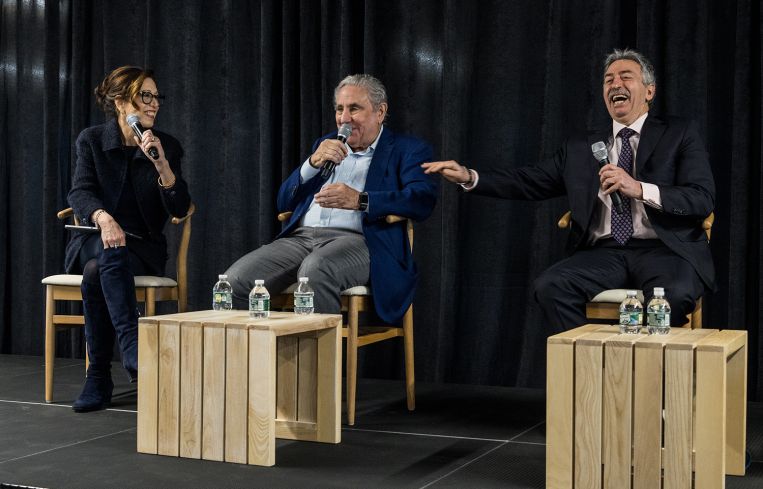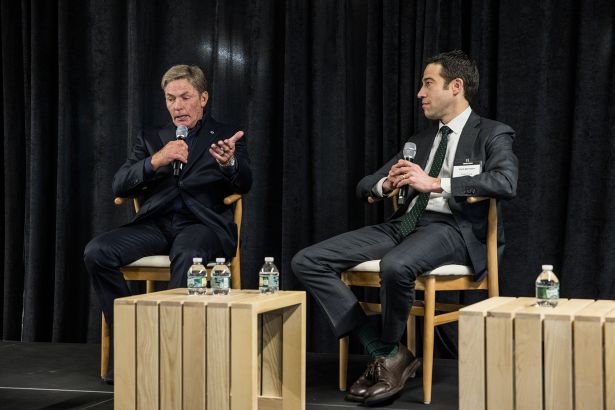What’s Ahead in New York City Commercial Real Estate?
Commercial Observer gathered the experts
By Larry Getlen March 29, 2024 3:01 pm
reprints
For all the doom and gloom in the media about the current state of New York City, the truth is far more complex, including that there are many, many reasons to be optimistic about New York right now, and that the strength of its economy is reason No. 1.
At Commercial Observer’s Future of New York event, which took place at 5 Times Square on March 28, panelists and keynote speakers delivered an honest assessment of the city’s current highs and lows while emphasizing the essential need for more cooperative government at both the state and city levels.
After opening remarks from Observer Media CEO James Freiman and SL Green Chief Investment Officer Harrison Sitomer, the day’s first keynote found Toby Dodd, Northeast regional president of Cushman & Wakefield, moderating a discussion with Kathryn Wylde, CEO of the Partnership for New York City, and Angela Pinsky, head of government affairs and public policy for Google.
Wylde quickly set the tone with a declaration of the considerable strength of New York City’s economy right now.
“Today, our economy is larger than it’s ever been. Our economic output is over $1 trillion a year. We’re the largest economy in the world aside from Tokyo,” said Wylde, noting that, even there, Tokyo counts its entire region in its measurement while New York counts only the five boroughs. “We had 144 million passengers go through our regional airports last year, which is an all-time record, and tourism will be back at full force by 2025. We had 44,000 new businesses formed in the city in the last two years, and we have 4.1 million private sector jobs, which is an all-time record and one that we hope to continue to build. So our problem in New York is not our economy.”
Speaking from a tech sector perspective, Pinsky echoed the optimism.
“The tech sector is mirroring a lot of what Kathy is talking about,” said Pinsky. “We’re seeing a lot of growth. Tech is now the fastest-growing industry in the city. Google just opened St. John’s Terminal, which is now the headquarters for our global business operations, which is our client-facing services. The reason why that investment was such a good one for Google is because a lot of our clients are actually here. The dynamics of New York that make it attractive are still very strong.”
That said, Wylde then addressed how city spending and costs have soared out of control.
“City spending has gone up 52 percent in the last 10 years, and it is unsustainable,” said Wylde. “We have a strong tax base, and they have bailed themselves out the last couple of years because of it. But that is not going to last if we abuse it.”
Shifting to the housing crisis, Wylde turned to the rise of housing costs and the loss of the 421a tax abatement for residential development, which would be the day’s most recurring theme along with the need for government relief in the matter.
“The housing crisis is a matter of public policies that for the past 50 years have added requirements on design, time, approval and liability to the cost of construction, which in turn has raised our cost of housing construction beyond anything I would have imagined in the `80s,” said Wylde.
Addressing possible solutions, Wylde said that political participation from people in the commercial real estate industry is “absolutely critical.”
“You cannot leave that to your trade associations. We have to start developing direct relationships between business leaders, their employees and the legislators,” said Wylde. “There has been a lack of trust that is worse than I’ve ever seen between government and everybody else, and, if we don’t develop personal relationships and become a resource to government, they’re going to continue to do dumb things. So that’s my pitch. Take your councilwoman to lunch, and let them pay their 50 percent.”
The panel titled “2024 Economic Outlook: Real Estate as the Ultimate Economic Driver,” was moderated by Suri Kasirer, president of the government relations firm Kasirer, and it built on Wylde’s themes.

“I think people are sitting back,” said Jonathan Mechanic, chairman of law firm Fried Frank’s real estate department, referring to multifamily development in the city. “You can’t really do multifamily development except in extraordinary circumstances without the benefit of government incentives. We really need all the people in the room and everyone else in the city to get behind the legislators and say, ‘We really need this kind of tax abatement. It’s the only way we’re going to build new affordable housing.’ Holding it hostage to good cause eviction is making it very difficult to get done.”
Both Kasirer and Shelah Wallace, a senior director of originations at Nuveen Green Capital, spoke about how environmentally focused C-PACE financing could be a potential answer for some of CRE’s office woes.
Greg Gomer, CFO of proptech firm HqO, spoke about how free breakfast was a surprisingly powerful tool for attracting people back to the office, and Jeffrey Gural, chairman of GFP Real Estate, had what might be the ultimate solution for getting people to return to the office.
Gural, through his ownership of the Meadowlands Racetrack, wound up with around 30 tickets each for recent concerts by Taylor Swift and Beyoncé, and set up a giveaway for employees.
“If you came in on Friday, you got to enter the contest,” said Gural, adding of companies: “You’ve got to be creative.”
After a keynote conversation between Fried Frank partner Zach Bernstein and Fisher Brothers co-managing partner Ken Fisher, a spotlight session on tenant representatives and landlord agency discussions saw Josh Kuriloff, executive vice chairman at Cushman & Wakefield, note that with $29 billion spent last year on artificial intelligence startup companies, odds were strong that New York’s booming tech sector will reap benefits from this exploding industry.
Other panelists included David Goldstein, tri-state president for Savills; moderator and Kramer Levin partner Josh Winefsky; and David Falk, tri-state president for Newmark. Falk added another note of optimism by citing how within the city’s top 45 buildings, the vacancy rate is only 8.5 percent.
“That’s very healthy,” said Falk.
SL Green Chairman and CEO Marc Holliday, interviewed by Commercial Observer Editor in Chief Max Gross, then spoke about how the current lending environment was stronger than it might appear.
“I’ve done business in much worse, and I know a lot of people here have as well,” said Holliday. “The issue to me is not the level of rates, it was the rapid run-up of rates. You can’t only work with historically low rates. I’m mostly focused now on new opportunities in this rate environment, which I think is one of the best investment landscapes I’ve seen since the early `90s.”
Paul “Tad” O’Connor, partner and co-chair of the real estate litigation practice at Kasowitz Benson Torres, moderated a panel on reimagining Midtown. It featured Nate Bliss, chief of staff to the deputy mayor for housing, economic development and workforce; Jeffrey Nelson, executive vice president of RXR’s investment management group; and Dean Shapiro, global head of development at Oxford Properties, who spoke about the success of Hudson Yards, noting that it could never have occurred without government incentives.
“None of that would have happened without the city doing critical things, like creating zoning latitude and, most importantly, significant infrastructure investments, namely the No. 7 train,” said Shapiro. “If you look at the birth of new neighborhoods in New York, it always starts with demonstrative public sector activity. When you look at Midtown, I believe it will require the public sector to create appropriate incentives, and this process will repeat itself.”
During a housing forecast panel, Aida Stoddard, senior vice president of development at MAG Partners, and moderator Basha Gerhards, senior vice president of planning at the Real Estate Board of New York, noted that while dealing with just a 1.41 percent vacancy rate, it takes 272 days to lease an apartment from city lotteries compared to just a few days for market-rate apartments.
To fully address housing difficulties in New York City, every possible solution — including a 421a replacement, conversion incentives and more — will be needed.
“It’s not an either/or proposition,” said Gerhards. “We’re going to need all of these things if we’re going to meet the very ambitious housing goal that the mayor and the governor have set for New York City of 500,000 units [over 10 years]. That’s about 50,000 units a year. Last year we permitted 9,909. That production goal is also one of the highest production goals we’ve seen since the 1920s. So we definitely need all of the tools.”
The housing panel also included LMXD Managing Director Katherine Kelman and Eric Ramirez, an Acore Capital managing director and co-head of its Eastern originations.
The event’s final discussion tackled neighborhood development and the importance of the city’s central business districts (BIDs). Moderated by Sarah Berman, executive director of the Avenue of the Americas Association and president of PR and marketing firm The Berman Group, the panel included a slew of leaders of the city’s business improvement districts: Long Island City Partnership President Laura Rothrock, Downtown Brooklyn Partnership President Regina Myer, Grand Central Partnership President and CEO Alfred Cerullo III, and Jeffrey LeFrancois, executive director of the Meatpacking District Management Association.
Given that BIDs are known to measure extensive neighborhood statistics, the panelists ended the event with an infusion of optimism, with Cerullo noting that December saw his area’s highest pedestrian counts since 2019, and LeFrancois noting similar numbers in the Meatpacking District from just a few weeks before, when temperatures hit 70 degrees.
“We broke every record for pedestrians two weeks ago over the last three years, even over September Fashion Week,” said LeFrancois. “We crushed that record. That makes me very excited for the summer.”


